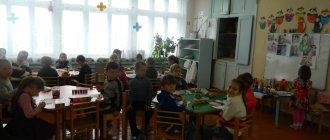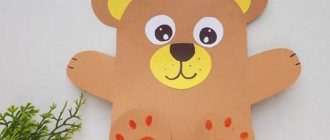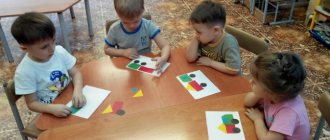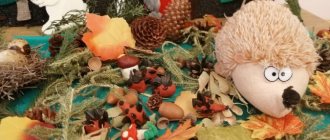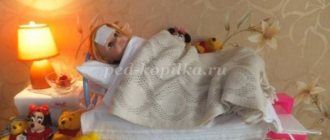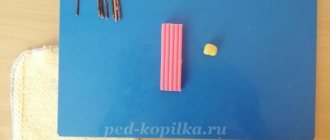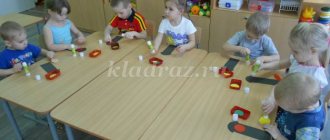The procedure for making an application with a photo
The first example is a trolleybus with two windows.
After completing the application, it is worth making an exhibition of children's works so that the kids have an incentive for further work
Instructions:
- We show the children the toy.
- Let's start with the largest part - the interior. Take a large rectangle and round the top corners.
- From square blanks, rounding the corners, we make wheels.
- We attach them to the interior.
- We also apply the smallest window squares to a rectangle with a rounded top.
- We apply current collector strips to the top.
- Glue the parts to the base.
The next version is more complicated. It requires cutting and pasting not only windows, but also doors.
If in class the children have already made an appliqué bus, then making a trolleybus will not be difficult for them
Instructions:
- Take a large rectangle, do not round the corners.
- Glue it onto the base.
- Cut out 2 wheels (from squares).
- We glue rectangles of windows to the left and right of the interior body.
- Let's start gluing the doors.
- We take a rectangle, add a small rectangle to the narrow side - steps.
- In the middle we draw a line - a sliding door.
- Repeat steps 6–7 again for the second door.
- Glue the doors to the center of the wheels.
- There is another window between the doors.
Video: How to make a “Trolleybus” application
Applique in the older group is one of the most favorite activities for kids. That is why it is so convenient to consolidate new information received with its help. Thus, when studying the topic “Transport”, each type of ground or underground (water) vehicle can be completed by creating a creative project - an application. Moreover, this also helps to consolidate knowledge about simple geometric shapes, as well as how they can be made from one shape to another. At the end of studying the topic, the teacher has the opportunity to make a large exhibition of the toddlers' works.
Applique for children steam locomotive
A colorful applique for children “Locomotive” with funny animals can be made in several versions: from plain paper, colored cardboard, or multi-colored felt.
You can put any animals or photos of your family members in the train windows, and, for example, stick a photo of your baby in the driver’s window. And then you will get a wonderful family photo. If there are many relatives, then you can increase the number of carriages. This is a great option for decorating a children's group photo.
This application can be made in the form of a greeting card and given to someone on their birthday.
Here are the materials for the paper appliqué “Train Engine” - a forest background and the details of the train itself. All you need to do is download, print and cut them out for your kids. You will find a link to download application templates at the end of the article.
If you are making an applique with a small child, then first you need to schematically put the parts together on paper to make it easier for the child to understand. And then proceed directly to gluing the parts.
Older children, 4 - 5 years old, should be given the opportunity to assemble a train on their own.
Good luck and interesting activities!
Paper locomotive applique for children
Paper locomotive applique for children
Paper locomotive applique for children
Paper locomotive applique for children
Paper locomotive applique for children
Cartoon about a train from the Children's Corner channel
Summary of GCD in the middle group according to the Federal State Educational Standard. Application. “We are going...to distant lands!”
Summary of direct educational activities in accordance with the Federal State Educational Standard for Educational Education on artistic and aesthetic development on the topic: “We are going, going, going to distant lands!” for children of middle preschool age with the integration of educational areas.
Main educational area: Artistic and aesthetic development
Integration of areas: cognitive development, speech development, physical development, social and communicative development.
Types of children's activities: visual, gaming, communicative, cognitive-research, motor, musical.
Goal: strengthening the ability to compose a multi-element composition from individual parts.
Objectives: Educational: - repeat and consolidate cutting skills (circles from a square, cutting off the corners of a large rectangle), bending a small rectangle in half and cutting along the fold line, neat gluing techniques; Developmental: - develop fine motor skills; motor skills, speed. Educational: - instill skills to work in a team, in subgroups - divide by color; - Cultivate kindness towards each other.
Target guidelines for preschool education: interested in visual children's activities (application “Steam Locomotive”); masters basic movements in accordance with age; shows interest in participating in outdoor games and finger gymnastics; actively and kindly interacts with the teacher and peers in solving gaming and cognitive problems.
Preliminary work: - examination of illustrations on the topic “Transport” - reading V. Suteev “Different Wheels”, A. Raskin “How Dad Threw the Ball Under the Car” - board games “Road Signs”, “Crossroads”, “Four Wheel”, “ Professions" - teaching the symbol corresponding to each type of transport? (for air transport - a cloud, for water transport - waves, and for land transport - a dark stripe "ground") - learning finger gymnastics "Journey" - preparation for GCD: learning the ability to cut a round shape from a square, cutting off the corners of a rectangle; folding a small rectangle in half and cutting along the fold line.
Methods and techniques: playful, visual, practical activities for children, questions for children, verbal didactic games, use of riddles.
Form of organization of children's activities: frontal, group, pair, individual.
Materials and equipment: - diagram for the application "Trailer" - (shown on TV) - songs by V. Shainsky "Blue Train" - audio tape recorder (background music) - pictures - designation "Differentiation of transport", pictures of transport (ground, air, water ). — Photos of the Krasnoyarsk Territory “Mountains”, “Lake”, “Field”, “Village”, “Forest”.
Handouts: - photographs of children; tray, scissors, glue, brushes, oilcloth, napkins for each child; rectangles of different colors (for choosing a carriage), blue rectangles (for squares - windows); black squares (for wheels).
Structure and methodological techniques: I. Introductory part (4 minutes): a) conversation and asking a riddle; b) verbal didactic game “Yes - no” II. Main part (15 minutes): a) subgroup work - division into subgroups “Differentiation of transport” b) finger gymnastics “Travel” c) work at tables III. Final part (1 minute): a) teacher’s generalization b) analysis of GCD (children’s knowledge) c) outdoor game “Train”
Progress of direct educational activities:
I. Introductory part (4 minutes):
Educator: Guys! An unusual package has arrived! Are you interested in knowing what's in it? (Yes) Educator: How can you find out what is there? (Children's answers). You can open it and look, or you can shake it without opening it. What do you think is there?
Didactic game "Yes-no". Children ask a question, and the teacher answers with the word “yes” or “no.” Children guess what is in the package. If they find it difficult to complete the task, the teacher suggests guessing the riddle “Iron huts are attached to each other. One of them with a pipe is carrying us all along.”
Children: steam locomotive.
Educator: Well done, guys! Of course it's a train. (The teacher takes out a locomotive from the box). Friends, what is missing here (Cars at the locomotive). How many carriages does a locomotive have? (A lot) And what happens to carriages (Wheels and windows). What shape are the wheels? (Round shape) Can they be square? (No, why? (Children's answers: they wouldn't roll the train)
II. Main part (15 minutes):
Subgroup work “Differentiation of transport”
Educator: Guys, what type of transport is the train? That's right, to land transport! What other transport do you know? (Children's answers). Or maybe you can help me arrange pictures for each type of transport according to the place of travel: land, air, water! Tell me, what symbol do you think corresponds to each type of transport? (for the air – a cloud, for the water – waves, and for the ground – a dark stripe “ground”).
Children are divided into subgroups based on the color of chips and stickers on their T-shirts. They lay out pictures with types of transport: water - boat, ship; ground - bus, car, steam locomotive; air - airplane, helicopter. Children justify their choice with a complete sentence.
Educator: Guys, while you were dismantling the transport for its intended purpose, I saw a note on the train. It says here that this little engine wanted to take everyone on a trip to their native land. But he can't do it. Why do you think? (no trailers). And he really wants to go on a trip with a fun, friendly company - with you guys! How can I help him? (children's answers - make trailers)
Educator: Correct! Let's make trailers, but they will not be simple, but colorful and bright. And then, together with the train, we will go on an exciting journey through our native land! Guys! Go to the creative workshop and see what is there?
Children: (geometric shapes: rectangles and squares).
Educator: These figures will help us create trailers. Choose a blank for the trailer, what color you like. (Children choose a blank for applique.)
Let's sit down on the chairs at the tables.
Individual work: Based on the diagram - a hint shown on TV, the teacher asks several children what this diagram means - the child pronounces the progress of the work, if he said it wrong, another child corrects him.
Explanation of the progress of the work being performed:
Educator: Guys, the diagram will help you in your work. (Children perform applique based on the diagram).
Description of preliminary work - paste ready-made geometric shapes. Large rectangles will be trailers, you just need to round off their upper corners. Fold a small rectangle in half and cut along the fold line - there will be windows. Cut out wheels from black squares, smoothly cutting off the corners. Glue the car to the base, stick two windows and two wheels on each car.
Educator: But before we start working, let's prepare our fingers. Finger gymnastics “Journey” Knock-knock-knock! Knock-Knock! Our ears hear a knock (near the ear, each finger taps the thumb 3 times) The wheels are knocking, the trailers are in a hurry! (rubbing fists together) Are you ready for the trip? (rotational movements with hands) Yes! Yes! Yes! (open palms) We'll hit the road again: (rotational movements with hands) Yes! Yes! Yes! (open your palms) A train is coming, (move the edge of your palm over your knees) The wheels are knocking. (fists knock on knees) There are a lot of funny guys on the train! (we use our fingertips to press on our knees one by one) We will now carry out the work. We will strictly follow the safety rules. Do not wave the scissors. Hold them carefully.
Children perform work to the song “Blue Car” by V. Shainsky
Educator: Guys, it’s much more pleasant and interesting to go on a trip yourself, having been on our train, so I suggest you take your seats in the carriages. Pasting your photos. (Children paste their photographs into the windows of the trailers. Collect all the works into one composition “Train”, take them in their hands).
Reflection (GCD analysis):
Educator: Guys, do you think our train is ready? (Ready) Let's pay attention to what we tried to do? (Children's answers). How did our trailers turn out? (We got neat and bright carriages for our little train) What parts does the carriage consist of? (Cabin, windows, wheels) Well, can we now go on a trip? (Yes)
In free time from classes: Outdoor game “Train” Children line up in a column on one side of the playground or along the wall of the room. The first one standing in the column is a “locomotive”, the rest are “cars”. The teacher blows the horn and the children begin to move forward (without clutch); at first slowly, then faster and finally running. “The train is approaching the station,” says the teacher. The children slow down and stop. Look how beautiful it is outside the window. What do we see? High mountains, wide fields, deep lakes. We drive further - here we are in the village, what animals we met here: Dog, Horse, Sheep, Cow. We pass through a dense forest, I wonder what animals we will meet in it? Fox, Wolf, Hare, Bear.
(Possible changes in p/a): The teacher gives a horn, and the children begin to move forward (without clutch); at first slowly, then faster and finally running. “The train is approaching the station,” says the teacher. Children slow down, stop and go in different directions. The teacher blows the whistle again, and the train moves again. Children must remember their place in the column and stand behind a certain person. The teacher regulates the pace and duration of the children's movement. The teacher blows the whistle again, and the train moves again. Children must remember their place in the column and stand behind a certain person. The teacher regulates the pace and duration of the children's movement.
Resulting stage:
Educator: Thank you for the interesting games and for the craftsmanship of the funny trailers. I have a proposal, let’s make an album out of this train, because you made the carriages with your photographs, and you will look at them and remember how we traveled. (The children agreed to create an album)
Software tasks:
— To consolidate knowledge on the topic “transport”, to cultivate respect for professions in transport.
— Improve the ability to carefully work with paper and glue, cut corners of squares and rectangles, create a holistic composition from elements, develop color perception and fine motor skills.
- Practice cutting out objects of the same shape from paper folded like an accordion.
— Continue to develop the ability to evaluate created images.
Equipment:
— Pictures depicting a variety of vehicles.
Materials for application:
— PVA glue, brushes, napkins, oilcloths, A4 size white cardboard with a pre-drawn railroad, geometric parts made of colored paper, scissors.
Preliminary work:
— Observation of transport, examination of subject and plot pictures on the topic “Transport”, didactic games on the topic, conversations about traffic rules, professions in transport, reading fiction on the topic.
Progress of the lesson.
1. Organizational moment.
All the children gathered in a circle: YOU are my friend and I am your friend! Let's hold hands tightly and smile at each other! (Children stand in a circle and give each other a smile.)
Smiling at each other, you gave a piece of good mood to your friend. When a good friend is nearby, then any trouble is not terrible. It's always more fun with a friend. You agree with me?
2. Motivational moment.
It’s especially nice to go on a trip with a friend.
— Would you like to go on a trip with your friend? (Children's answers.)
Tell me, what can you use to hit the road? (Children list types of transport.)
- Well done! You named many types of transport: water, air, and land.
D/i with the movements “Rides, swims, flies” (land transport - children hold the steering wheel, air transport - they depict the wings of an airplane, water transport - they show how they float).
- Well done! We did it!
— Now listen carefully to the riddle about one of the modes of transport: Iron huts
Attached to each other.
One of them with a pipe
Leads everyone with him. (Train.)
Looking at an illustration of a train.
- Let's see what the train consists of? In front of you is a steam locomotive - the main carriage, in which the driver sits and controls the train. Attached to the locomotive are carriages in which passengers travel. Look at what parts it consists of? (It has walls, wheels and windows.)
A train has a lot of cars, and such a train is called a train.
— Do you want to travel by train?
Then off to the carriages!
Physical exercise “A train is rushing.”
Choo-choo! Choo-choo!
The train is rushing at full speed.
(Children run in a circle one after another, placing their hands on the shoulders of the child in front.)
The locomotive is chugging.
I'm in a hurry! - it buzzes.
I'm in a hurry! I'm in a hurry!
(The first child makes circular movements with his arms bent at the elbows and pronounces the sound of a steam locomotive.)
3. Main part.
“Now let’s take our seats.”
Look, there is a railway, but the train has not yet arrived at the station. What to do? How should we go on our journey? (Children's proposals to make the train themselves.)
You have parts for our train on your table. Let's look at them carefully and think about what can be made from them.
We will make carriages from large rectangles, round wheels from squares, and windows from a narrow strip by folding.
The teacher shows how to do it. Afterwards, the children begin to work independently. Review the rules for safe handling of scissors.
4. Reflection.
- Guys, look how wonderful our trains turned out!
Now you can safely go on a trip!
Well done everyone!
